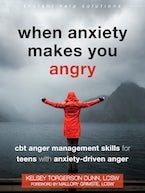By Kelsey Torgerson Dunn, MSW, LCSW, author of When Anxiety Makes You Angry
Have you ever gotten in trouble for something that’s not actually your fault? It’s probably happened to everyone at least once. You get blamed and chastised, and you feel a sharp, spiky feeling. Maybe it makes you feel scared, or anxious, or guilty. Maybe it makes you feel angry.
When you got in trouble, how did you react? What did you do? Did you calmly say “okay,” or did you, like many people, feel like you wanted to defend yourself? Did you stay quiet the rest of the day? Did you want to leave and go home as soon as possible? Did you shout, or yell, or get really tense in your whole body, and feel ready to explode?
If getting in trouble was stressful for you, your body may have started experiencing the beginnings of a fight, flight, or freeze reaction. Fight/Flight/Freeze is an automatic response that occurs when your brain tells you that you’re in danger.
It is a super helpful response when you’re actually in —like when you’re strolling through the jungle and suddenly there’s a big tiger. It instinctively tells you to fight that tiger, or run away, or freeze and play dead. Great responses from our caveman days when we were in danger all the time! Not so great when you’re in class and your teacher tells you to quiet down, even though you weren’t the only one talking.
Our brains and bodies can’t always separate actual danger from things that are just stressful, so people with anxiety who get in trouble in class might want to run out of the classroom, or freeze and stay quiet for the rest of the day. It’s easy to see how these reactions are due to anxiety.
It’s not always automatically clear that those people who want to shout at the teacher, mouth off, or get furious might be responding with anxiety, too. Fight is an equally valid anxious reaction, but the external anger masks the underlying anxiety. And when the fight response happens again and again, parents, teachers, and peers are prone to see you as an angry person—not an anxious one.
What is anxiety-driven anger?
When you respond with fight responses due to your anxiety, we can label this as “anxiety-driven anger.” Anxiety-driven anger is anger due to underlying anxiety issues. Rarely if ever is a person just angry. There’s usually something going on underneath it.
If you’re the kind of person who responds with a “fight” response in stressful situations, you’re experiencing anxiety-driven anger. You may look very angry on the outside, but inside you’re feeling all this stress, fear, and anxiety. My book, When Anxiety Makes You Angry, is all about digging into the anxiety that’s underneath angry outbursts, and learning ways to cope with it, so that you feel in charge of your responses rather than your responses being in charge of you.
How to cope with anxiety-driven anger
Coping with anxiety-driven anger takes a lot of work, and there are a lot of pieces involved. So many pieces, in fact, that I wrote a whole book! So, if you want to learn about what’s really going on underneath your anger; if you want to be able to get a clearer understanding of your emotional levels, triggers, and building your tolerance to stress; if you want to learn how to tell yourself helpful things instead of exploding all the time, you know where to find this information. I hope you check out When Anxiety Makes You Angry!
But in the meantime, if we really want to drill down to coping with anxiety-driven anger, we’re going to need some coping skills. So below, you’ll find my three favorite ways to cope with anxiety-driven anger.
Breathing Exercises
When we’re experiencing anxiety or anger, our breathing naturally speeds up. That means the best way to help our body relax is to slow down and regulate our breath. There are tons of different breathing activities you can find, but my favorite is heart and belly breathing.
Place one hand on your heart and one hand on your belly. If you feel comfortable with it, close your eyes. Then just slowly breathe in through your nose and out through your mouth. As you breathe in, feel that air traveling from your lungs, down to your heart, filling up your belly. As you breathe out, feel that air release from your belly, up back through your heart, and out your mouth. Repeat at least five times, until you notice your body calming.
Muscle Exercises
Muscles naturally tense when we feel anxious, so to calm down, you’ll need to find ways to help your muscles relax and soften. Exercise, like running, lifting weights, or Pilates, help those muscles tense up in the moment and then relax after the exercise is complete, so they can be particularly helpful as a regular practice. Unfortunately, we can’t go for a run every time our dad makes us do the chores even though it’s NOT EVEN OUR TURN to empty the dishwasher, so it’s good to have some muscle relaxation strategies that you can quickly implement.
A quick tool is one I like to call “squeezing lemons.” Take your fists and squeeze them really, really tight, just like you’re squeezing lemons for lemonade. Hold for five counts, and then relax. Repeat three times, and then shake them out, releasing any remaining tension.
Mindfulness Exercises
Often, whether we feel anxious or angry, our brain can feel like it’s swirling around with tons of thoughts. When we practice a mindfulness activity, we give our brain something to think about besides the issue that’s stressing us out. Mindfulness exercises are personally my favorite way to manage anxiety, and there are tons of meditation and mindfulness tools you can find online (and in my book, and at www.kelseytorgersondunn.com).
One of my favorite grounding tools is the Five Senses Scavenger Hunt. Wherever you’re sitting, look around the room, and notice one thing you see. Really notice the detail of it, including the color, and brightness, and any textures you can see. Pause for a moment. Then, close your eyes and notice one thing that you hear, focusing closely on the quality of the sound. Next, notice one thing that you smell in the room—maybe laundry, or your snack, or dinner cooking in the kitchen. Wherever your hands are, notice one thing that you touch. Notice the texture, and the temperature. Then, notice how your mouth tastes, and how your tongue feels in your mouth. When you’re ready, open your eyes.
Breathing, muscle, and mindfulness exercises will help you manage your anxiety-driven anger in the moment, but they’re also really great to practice when you’re already feeling calm.
The more you practice, the easier they are to recall in the moment. And, regular relaxation practice has the added benefit of generally building your stress tolerance levels, so that you can handle more and more stress before you explode.
So, the next time you get in trouble, even when it’s not really your fault, take a moment to notice that spike of emotion, and use a breathing, muscle, or mindfulness tool before you react. If that helps, wonderful! If you feel like you need more tools, consider reading When Anxiety Makes You Angry. Just make sure to remember that feeling anxious or angry is okay. It’s what you do about the feeling that’s really important.
Kelsey Torgerson Dunn, MSW, LCSW, specializes in anxiety and anger management therapy for kids, teens, and college students. She opened her group practice, Compassionate Counseling St. Louis, in early 2017. She practices cognitive behavioral therapy (CBT), acceptance and commitment therapy (ACT), and mindfulness skills, and often finds that just having someone on your side is the most helpful part of counseling.



 2024 Peace Playbook: 3 Tactics to Avoid Clashes with Your Partner
2024 Peace Playbook: 3 Tactics to Avoid Clashes with Your Partner